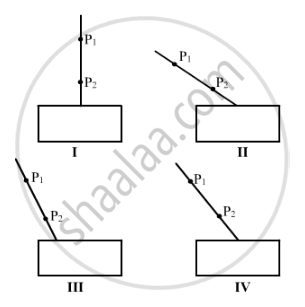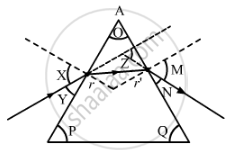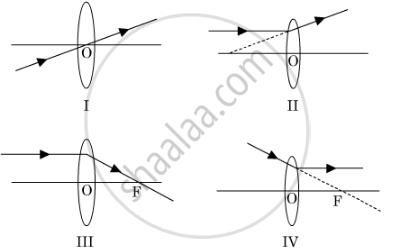English Medium
Academic Year: 2013-2014
Date: मार्च 2014
Advertisements
Write the number of vertical columns in the modern periodic table. What are these columns called?
Chapter: [0.05] Periodic Classification of Elements
Give the respective scientific terms used for studying the mechanism by which variations are created and inherited
Chapter: [0.08] Heredity
Give the respective scientific terms used for studying the development of new type of organisms from the existing ones.
Chapter: [0.08] Heredity
Water is a valuable resource. List two ways, that you would suggest every family member to save this resource.
Chapter: [0.16] Sustainable Management of Natural Resources
List two advantages of vegetative propagation.
Chapter: [0.07] How do Organisms Reproduce?
Draw a ray diagram to show the path of the reflected ray corresponding to an incident ray of light parallel to the principal axis of a convex mirror and show the angle of incidence and angle of reflection on it.
Chapter: [0.09] Light - Reflection and Refraction
Why is Government of India imposing a ban on the use of polythene bags? Suggest two alternatives to these bags and explain how this ban is likely to improve the environment.
Chapter: [0.13] Our Environment
What is meant by biodiversity? List two advantages of conserving forests and wild life.
Chapter: [0.16] Sustainable Management of Natural Resources
State the meaning of functional group in a carbon compound.
Chapter:
Write the functional group present in (i) ethanol and (ii) ethanoic acid and also draw their structures.
Chapter:
Write the name and general formula of a chain of hydrocarbons in which an addition reaction with hydrogen is possible. State the essential condition for an addition reaction. Stating this condition, write a chemical equation giving the name of the reactant and the product of the reaction.
Chapter: [0.04] Carbon and its Compounds
Based on the group valency of elements state the formula lot the following giving justification for each :-
(i) Oxides of 1st group elements,
(ii) Halides of the elements of group 13, and
(iii) Compounds formed when an element of group 2 combines with, an element of group 16.
Chapter: [0.05] Periodic Classification of Elements
Define the term : Valency
Chapter: [0.05] Periodic Classification of Elements
Define the term : Atomic size
Chapter: [0.05] Periodic Classification of Elements
How do the valency and the atomic size of the elements vary while going from left to right along a period in the modern periodic table?
Chapter: [0.05] Periodic Classification of Elements
Explain the process of regeneration in Planaria.
Chapter: [0.07] How do Organisms Reproduce?
List any four methods of contraception used by humans. State in brief two advantages of adopting such preventive methods.
Chapter: [0.07] How do Organisms Reproduce?
"Birds have evolved from reptiles" State evidence to prove the statement.
Chapter: [0.08] Heredity
Advertisements
Insects, octopus, planaria and vertebrates possess eyes. Can we group these animals together on the basis of eyes that they possess ? Justify your answer giving reason.
Chapter: [0.08] Heredity
A cross was made between pure breeding pea plants one with round and green seeds and the other with wrinkled and yellow seeds.
(a) Write the phenotype of F1 progeny. Give reason for your answer.
(b) Write the different types of F2 progeny obtained along with their ration when F1 progeny was selfed.
Chapter: [0.08] Heredity
A spherical mirror produces an image of magnification -1 on a screen placed at a distance of 50 cm from the mirror.
(a) Write the type of mirror.
(b) Find the distance of the image from the object.
(c) What is the focal length of the mirror?
(d) Draw the ray diagram to show the image formation in this case.
Chapter: [0.09] Light - Reflection and Refraction
If the speed of light in vacuum is 3 × 108 ms−1, find the speed of light in a medium of absolute refractive index 1.5.
Chapter: [0.09] Light - Reflection and Refraction
Explain giving reason why the sky appears blue to an observer from the surface of the earth? What will the colour of the sky be for an astronaut staying in the international space station orbiting the earth? Justify your answer giving reason.
Chapter: [0.1] The Human Eye and the Colourful World
"Our food grains such as wheat and rice, the vegetables and fruits and even meat are found to contain varying amounts of pesticide residues." State the reason to explain how and why it happens?
Chapter: [0.13] Our Environment
State the reason why carbon can neither form \[\ce{C^4+}\] cations nor \[\ce{C^4−}\] anions but forms covalent compound.
Chapter: [0.03] Metals and Non Metals [0.04] Carbon and its Compounds
State the reason to explain why covalent compounds "are bad conductors of electricity".
Chapter: [0.03] Metals and Non Metals [0.04] Carbon and its Compounds
State the reason to explain why covalent compounds "have low melting and boiling points."
Chapter: [0.03] Metals and Non Metals [0.04] Carbon and its Compounds
Give one example of a unisexual flower.
Chapter: [0.07] How do Organisms Reproduce?
Mention the changes a flower undergoes after fertilisation.
Chapter: [0.07] How do Organisms Reproduce?
How does the amount of DNA remain constant though each new generation is a combination of DNA copies of two individuals?
Chapter: [0.07] How do Organisms Reproduce?
Name the respective part of human female reproductive system:-
(i) that produces eggs,
(ii) where fusion of eggs and sperm takes place, and
(iii) where zygote gets implanted.
Chapter: [0.07] How do Organisms Reproduce?
Describe in brief what happens to the zygote after it gets implanted.
Chapter: [0.07] How do Organisms Reproduce?
A student wants to project the image of a candle flame on the walls of school laboratory by using a lens:-
(a) Which type of lens should be use and why?
(b) At what distance in terms of focal length 'F' of the lens should be place the candle flame so as to get (i) a magnified, and (ii) a diminished image respectively on the wall?
(c) Draw ray diagram to show the formation of the image in each case?
Chapter: [0.09] Light - Reflection and Refraction
List three common refractive defects of vision. Suggest the way of correcting these defects.
Chapter: [0.1] The Human Eye and the Colourful World
Advertisements
About 45 lac people in the developing countries are suffering from corneal blindness. About 30 lac children below the age of 12 years suffering from this defect can be cured by replacing the defective cornea with the cornea of a donated eye. How and why can students of your age involve themselves to create awareness about this fact among people?
Chapter: [0.1] The Human Eye and the Colourful World
When you add about 2 ml of acetic acid to a test tube containing an equal amount of distilled water and leave the test tube to settle after shaking its contents, what will you observe in the test tube after about 5 minutes?
(A) A white precipitate settling at its bottom
(B) A clear colourless solution
(C) A layer of water over the layer of acetic acid
(D) A layer of acetic acid over the layer of water
Chapter: [0.04] Carbon and its Compounds
A student adds a few drops of ethanoic acid to test tubes X, Y and Z containing aqueous solutions of sodium chloride, sodium hydroxide and sodium carbonate, respectively. If he now brings a burning splinter near the mouth of the test tubes immediately after adding ethanoic acid in each one of them, in which of the test tube or test tubes the flame will be extinguished?
(A) X and Y
(B) Y and Z
(C) X and Z
(D) only Z
Chapter: [0.04] Carbon and its Compounds
In order to study saponification reaction, we first prepare 20% solution of sodium hydroxide. If we record the temperature of this solution just after adding sodium hydroxide flakes to water and also test its nature using litmus, it may be concluded that the process of making this solution is
(A) exothermic and the solution is alkaline
(B) endothermic and the solution is alkaline
(C) endothermic and the solution is acidic
(D) exothermic and the solution is acidic
Chapter: [0.04] Carbon and its Compounds
While studying saponification reaction for the preparation of soap, a teacher suggested to a student to add a small quantity of common salt to the reaction mixture. The function of common salt in this reaction is to
(A) reduce the alkalinity of the soap
(B) reduce the acidity of the soap
(C) enhance the cleansing capacity of soap
(D) favour precipitation of soap
Chapter: [0.04] Carbon and its Compounds
A student takes about 6 ml of distilled water in each of the four test tubes P, Q, R and S. He then dissolves an equal amount of four different salts namely, sodium chloride in 'P', potassium chloride in 'Q', calcium chloride in 'R' and magnesium chloride in 'S'. Next, he then adds 10 drops of soap solution to each test tube and shakes its contents. The test tubes in which scum (insoluble substance) is formed with soap are:
(A) P and Q
(B) Q and R
(C) R and S
(D) Q and S
Chapter: [0.04] Carbon and its Compounds
A student has obtained the image of a distant object with a concave mirror to determine its focal length. If he has selected a well-illuminated red building as object, which of the following correctly describes the features of the image formed?
(A) Virtual, inverted and diminished image in red shade
(B) Real, erect and diminished image in pink shade
(C) Real, inverted and diminished image in red shade
(D) Virtual, erect and enlarged image in red shade
Chapter: [0.09] Light - Reflection and Refraction
A student has obtained an image of a distant object on a screen to determine the focal length F1 of the given lens. His teacher, after checking the image, gave him another lens of focal length F2 and asked him to focus the same object on the same screen. The student found that to obtain a sharp image, he has to move the lens away from the screen. From this finding, we may conclude that both the lenses given to the student were :
(A) Concave and F1 < F2
(B) Convex and F1 < F2
(C) Convex and F1 > F2
(D) Concave and F1 > F2
Chapter: [0.09] Light - Reflection and Refraction
Study the following four experimental set-ups I, II, III and IV for the experiment, "To trace the path of a ray of light through a rectangular glass slab."

Which of the marked set-ups is likely to give best results (P1 and P2 are the positions of pins fixed on the incident ray)?
(A) I
(B) II
(C) III
(D) IV
Chapter: [0.09] Light - Reflection and Refraction
On the basis of the experiment, "To trace the path of a ray of light through a rectangular glass slab", students of a class arrived at which one of the following conclusions?
(A) Angle of incidence is greater than the angle of emergence.
(B) Angle of emergence is smaller than the angle of refraction.
(C) Emergent ray is parallel to the refracted ray.
(D) Incident ray and emergent ray are parallel to each other.
Chapter: [0.09] Light - Reflection and Refraction
The path of a ray of light passing through a glass prism is shown below:

In this diagram, the angle of prism, angle of incidence, angle of emergence and angle of deviation, respectively, have been represented by:
(A) O, Y, Z and N,
(B) P, Y, M and Z,
(C) O, X, M and Z,
(D) P, X, Z and N.
Chapter: [0.1] The Human Eye and the Colourful World
A student is observing a diagram showing the path of a ray of light passing through a glass prism. He would find that for all angles of incidence the ray of light bends:
towards the normal, while entering the prism and away from the normal while emerging from the prism
away from the normal while entering the prism and towards the normal while emerging from the prism
away from the normal while entering as well as while emerging from the prism
towards the normal while entering as well as while emerging from the prism
Chapter: [0.1] The Human Eye and the Colourful World
A student was asked by his teacher to find the image distance for various object distance in case of a given convex lens. He performed the experiment with all precautions and noted down his observations in the following table:
| S. No. |
Object distance (cm) |
Image distance (cm) |
| 1 | 60 | 15 |
| 2 | 48 | 16 |
| 3 | 36 | 21 |
| 4 | 24 | 24 |
| 5 | 18 | 36 |
| 6 | 16 | 48 |
After checking the observations table the teacher pointed out that there is a mistake in recording the image distance in one of the observations. Find the serial number of the observations having faulty image distance.
(A) 2
(B) 3
(C) 5
(D) 6
Chapter: [0.09] Light - Reflection and Refraction
A student has obtained a magnified image of a flame on a screen using a convex lens. To draw the corresponding ray diagram to show the image formation, which of the following two rays whose paths after refraction are shown, should he select ?

(A) I and II
(B) II and III
(C) III and IV
(D) I and III
Chapter: [0.09] Light - Reflection and Refraction
Study the following diagrams showing various stages of binary fission in Amoeba:

The correct sequence of these diagrams should be:
(A) I, IV, III, II, V
(B) I, III, IV, II, V
(C) I, II, IV, III, V
(D) I, II, III, IV, V
Chapter: [0.07] How do Organisms Reproduce?
Identify the figures showing the process of budding in yeast.

(A) I, II and III
(B) II, III and IV
(C) I, II and IV
(D) III, IV and I
Chapter: [0.07] How do Organisms Reproduce?
Which one of the following pairs of vegetables is an example of homologous structures?
(A) Potato and sweet potato
(B) Carrot and radish
(C) Carrot and tomato
(D) Tomato and radish
Chapter: [0.08] Heredity
Four students P, Q, R and S differently reported the following set of organs to be analogous :
P. Forelimb of a frog and forelimb of a lizard
Q. Forelimb of a bird and forelimb of a human
R. Wings of a parrot and wings of a butterfly
S. Wings of a bird and wings of a bat
The two students who have reported correctly are :
(A) P and Q
(B) Q and R
(C) R and S
(D) P and S
Chapter: [0.08] Heredity
You are asked by your teacher to study the different parts of an embryo of a gram seed. Given below are the steps to be followed for the experiment:
I. Soak the gram seeds in plain water and keep them overnight.
II. Cut open a soaked seed and observe its different parts.
III. Take some dry gram seeds in a petri dish.
IV. Drain the excess water.
V. Cover the soaked seeds with a wet cotton cloth and leave them for a day.
The correct sequence of these steps is :
(A) III, I, V, IV, II
(B) III, I, II, IV, V
(C) III, IV, V, I, II
(D) III, I, IV, V, II
Chapter: [0.07] How do Organisms Reproduce?
Other Solutions
Submit Question Paper
Help us maintain new question papers on Shaalaa.com, so we can continue to help studentsonly jpg, png and pdf files
CBSE previous year question papers Class 10 Science with solutions 2013 - 2014
Previous year Question paper for CBSE Class 10 Science-2014 is solved by experts. Solved question papers gives you the chance to check yourself after your mock test.
By referring the question paper Solutions for Science, you can scale your preparation level and work on your weak areas. It will also help the candidates in developing the time-management skills. Practice makes perfect, and there is no better way to practice than to attempt previous year question paper solutions of CBSE Class 10.
How CBSE Class 10 Question Paper solutions Help Students ?
• Question paper solutions for Science will helps students to prepare for exam.
• Question paper with answer will boost students confidence in exam time and also give you an idea About the important questions and topics to be prepared for the board exam.
• For finding solution of question papers no need to refer so multiple sources like textbook or guides.
